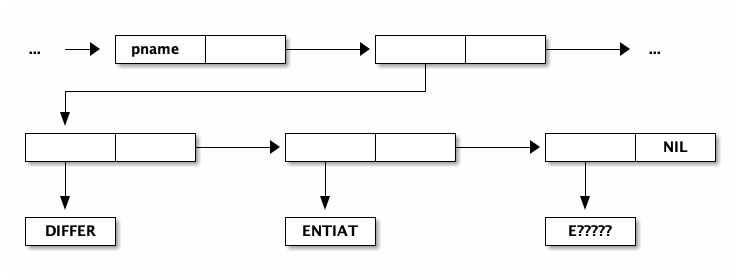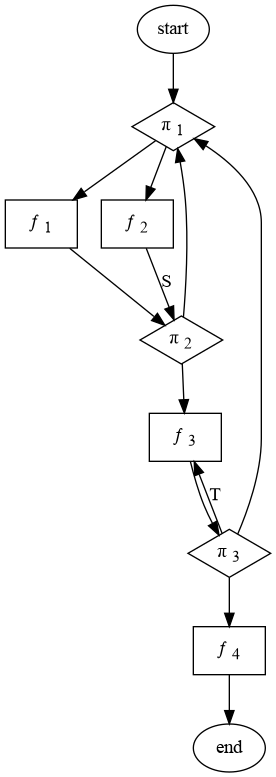Recursive Functions of Symbolic Expressions and Their Computation by Machine, Part 1
Overview
This page contains notes on the classic paper "Recursive Functions of Symbolic Expressions and Their Computation by Machine, Part 1" by John McCarthy.
§ 2 Functions and Function Definitions
Introduces the notion of a conditional expression!
Tidbit: McCarthy proposed the addition of a cond-like expression to
Algol 60, but it was rejected in favor of the English equivalent,
if ... then ... else.
Review of concepts:
- a. Partial Function
- a function that is only defined on part of its domain.
- b. Propositional Expressions and Predicates
- \(T, F, \wedge, \lor, \lnot\), etc.
- c. Conditional Expressions
- \((p_1 \rightarrow e_1, \cdots, p_n \rightarrow e_n)\)
- d. Recursive Function Definitions
- \(n! = (n=0 \rightarrow 1, T \rightarrow n (n - 1)!)\)
- e. Functions and Forms
- Describes λ-expressions and the distinction between "forms" and "functions." The term "form" is borrowed from Church.
- f. Expressions for Recursive Funcitons
- \(label(a, \mathcal{E})\) allows the definition of a recursive expression by giving the expression \(\epsilon\) the label \(a\) and permitting references to \(a\) inside \(\epsilon\).
§ 3 Recursive Functions of Symbolic Expressions
Defines S-expressions, plus five (five!) elementary functions and predicates, and builds up from those five, culminating in \(apply\).
a. A class of Symbolic Expressions
- Atomic symbols are S-expressions
- If \(e_1\) and \(e_2\) are S-expressions, so is \((e_1 \cdot e_2)\).
- \((m)\) stands for \((m \cdot NIL)\)
- \((m_1, \cdots, m_n)\) stands for \((m_1 \cdot ( \cdots (m_n \cdot NIL) \cdots ))\)
- \((m_1, \cdots, m_n \cdot x)\) stands for \((m_1 \cdot ( \cdots (m_n \cdot x) \cdots ))\)
b. Functions of S-expressions and the Expressions that Represent Them
Introduces M-expressions (meta-expressions)
\[ car[x] \] \[ car[cons[(A \cdot B);x]] \]
c. The Elementary S-functions and Predicates
d. Recursive S-functions
cond + recursion allows us to express all computable functions.
Here are some useful recursive functions.
\begin{align*} \text{ff}[x] = [&atom[x] \rightarrow x;T \rightarrow \text{ff}[car[x]]] \\ \\ subst [x; y; z] = [&atom[z] \rightarrow [eq[z; y] \rightarrow x; T \rightarrow z]; \\ &T \rightarrow cons [subst[x; y; car [z]]; subst[x; y; cdr [z]]]] \\ \\ equal [x; y] = [&atom[x] \wedge atom[y] \wedge eq[x; y]] \lor \\ [&\lnot atom[x] \wedge \lnot atom[y] \wedge equal[car[x]; car[y]] \wedge equal[cdr[x]; cdr[y]]] \\ \\ null[x] = &atom[x] \wedge eq[x;NIL] \end{align*}And some functions on lists.
\begin{align*} append[x; y] = [&null[x] \rightarrow y; T \rightarrow cons[car[x]; append[cdr[x]; y]]] \\ \\ among[x; y] = &\lnot null[y] \wedge [equal[x; car[y]] \lor among[x; cdr[y]]] \\ \\ pair[x; y] = [&null[x] \wedge null[y] \rightarrow NIL; \\ &\lnot atom[x] \wedge \lnot atom[y] \rightarrow cons[list[car[x]; car[y]]; pair[cdr[x]; cdr[y]]] \\ \\ assoc[x; y] = &eq[caar[y]; x] \rightarrow cadar[y];T \rightarrow assoc[x; cdr[y]]] \\ \\ sub2[x; z] = [&null[x] \rightarrow z; eq[caar[x]; z] \rightarrow cadar[x];T \rightarrow sub2[cdr[x]; z]] \\ \\ sublis[x; y] = [&atom[y] \rightarrow sub2[x; y];T \rightarrow cons[sublis[x; car[y]]; sublis[x; cdr[y]]] \end{align*}e. Representation of S-Functions by S-Expressions
How to translate M-expressions into S-expressions.
"The translation is determined by the following rules in which we denote the translation of an M-expression \(\mathcal{E}\) by \(\mathcal{E}^{\ast}\)"
- If \(\mathcal{E}\) is an S-expression, \(\mathcal{E}^{\ast}\) is \((QUOTE, \mathcal{E})\).
- Symbols get converted to uppercase. \(car^{\ast} \mapsto CAR, subst^{\ast} \mapsto SUBST\)
- \(f[e_1; \cdots; e_n] \mapsto (f^{\ast}, e_1^{\ast}, \cdots, e_n^{\ast})\). Thus, \(cons[car[x]; cdr[x]]^{\ast} \mapsto (CONS, (CAR, X), (CDR, X))\).
- \(\{[p_1 \rightarrow e_1; \cdots; p_n \rightarrow e_n]\}^{\ast} \mapsto (COND, (p_1^{\ast},e_1^{\ast}), \cdots, (p_n^{\ast},e_n^{\ast}))\)
- \(\{\lambda[[x_1;\cdots;x_n];\mathcal{E}]\}^{\ast} \mapsto (LAMBDA, (x_1^{\ast},\cdots,x_n^{\ast}), \mathcal{E}^{\ast})\)
- \(\{label[a;\mathcal{E}]\}^{\ast} \mapsto (LABEL, a^{\ast}, \mathcal{E}^{\ast})\)
f. The Universal S-Funciton, \(apply\)
Behold!
The S-function apply is defined by
\[ apply[f; args] = eval[cons[f; appq[args]];NIL], \]
where
\[ appq[m] = [null[m] \rightarrow NIL;T \rightarrow cons[list[QUOTE; car[m]]; appq[cdr[m]]]] \]
and1
\begin{equation*} \begin{split} eval[&e; a] = [ \\ &atom[e] \rightarrow assoc[e; a]; \\ &atom[car[e]] \rightarrow [ \\ & \quad \quad eq[car[e]; QUOTE] \rightarrow cadr[e]; \\ & \quad \quad eq[car[e]; ATOM] \rightarrow atom[eval[cadr[e]; a]]; \\ & \quad \quad eq[car[e]; EQ] \rightarrow [eval[cadr[e]; a] = eval[caddr[e]; a]]; \\ & \quad \quad eq[car[e]; COND] \rightarrow evcon[cdr[e]; a]; \\ & \quad \quad eq[car[e]; CAR] \rightarrow car[eval[cadr[e]; a]]; \\ & \quad \quad eq[car[e]; CDR] \rightarrow cdr[eval[cadr[e]; a]]; \\ & \quad \quad eq[car[e]; CONS] \rightarrow cons[eval[cadr[e]; a]; eval[caddr[e]; a]]; \\ & \quad \quad T \rightarrow eval[cons[assoc[car[e]; a]; cdr[e]]; a]]; \\ &eq[caar[e]; LABEL] \rightarrow eval[cons[caddar[e]; cdr[e]]; cons[list[cadar[e]; car[e]]; a]; \\ &eq[caar[e]; LAMBDA] \rightarrow eval[caddar[e]; append[pair[cadar[e]; evlis[cdr[e]; a]; a]]] \end{split} \end{equation*}and
\[ evcon[c; a] = [eval[caar[c]; a] \rightarrow eval[cadar[c]; a];T \rightarrow evcon[cdr[c]; a]] \]
and
\[ evlis[m; a] = [null[m] \rightarrow NIL;T \rightarrow cons[eval[car[m]; a]; evlis[cdr[m]; a]]] \]
g. Functions with Functions as Arguments
\[ maplist[x; f] = [null[x] \rightarrow NIL;T \rightarrow cons[f[x];maplist[cdr[x]; f]]] \]
\[ search[x; p; f; u] = [null[x] \rightarrow u; p[x] \rightarrow f[x];T \rightarrow search[cdr[x]; p; f; u] \]
§ 4 The LISP Programming System
a. Representation of S-Functions by List Structure
Introduces the boxes & arrows notation for cons cells. Substructure can be shared, but cycles are not allowed. Symbols are represented as "association lists" (property lists in modern usage) where the car is a magic constant indicating the cons is a symbol.
b. Association Lists (P-lists)
P-list may contain:
- print name
- symbol value (number, sexp, function)
A P-list is not a sexp. For example, the print name of a symbol is represented as follows:

c. Free-Storage List
- The system starts with ~15k words on the free list.
- Some fixed register contains the start address of the free list.
- To cons, pop words from the head of the free list.
- gc works as follows (standard mark & sweep):
- a fixed set of base registers serve as gc roots.
- don't collect until out of blocks on the free-list
- when out of memory:
- start from roots and mark all reachable words by negating the signs (essentially, first bit is a mark bit).
- if you find reg with sign, assume it's already been visited.
- sweep through the heap and put any un-marked words back on the free list and revert mark bits.
McCarthy notes that a gc cycle took several seconds to run!
d. Elementary S-Functions in the Computer
S-expressions are passed to / returned from functions as pointers to words.
- atom
- Test car for magic value, return symbol \(T\) or \(F\), unless appearing in \(cond\), in which case transfer control directly without generating \(T\) or \(F\).
- eq
- pointer compare on address fields. As above, generate \(T\) or \(F\) or \(cond\) transfer.
- car
- access "contents of address register".
- cdr
- access "contents of decrement register".
- cons
- \(cons[x;y]\) returns the location of a word with \(x\) in the car and \(y\) in the cdr. Doesn't search for existing cons, just pulls a new one from the free list. \(cons\) is responsible for kicking off a gc cycle when out of memory.
e. Representation of S-Functions by Programs
- SAVE/UNSAVE
- push/pop registers from/onto the "public pushdown list" (a.k.a. stack). Only used for recursive functions?
f. Status of the LISP Programming System (Feb. 1960)
- Can define S-Functions via S-expressions. Can call user-defined and builtin functions.
- Can compute values of S-Functions.
- Can read/print S-expressions.
- Includes some error diagnostics and selective tracing.
- May compile selected S-Functions.
- Allows assignment and
go to, ala ALGOL. - Floating point possible, but slow.
- LISP 1.5 manual coming soon!
§ 5 Another Formalism for Functions of S-expressions
So-called, L-expressions (Linear LISP).
- Permit a finite list of chars
- Any string of permitted chars is an L-expr, including the null string, denoted \(\Lambda\).
There are three functions:
- \(first[x]\) is the first char of \(x\). \(first[\Lambda] = \bot\).
- \(rest[x]\) is the string of chars remaining after first is deleted. \(rest[\Lambda] = \bot\).
- \(combine[x;y]\) is the string formed by prefixing \(x\) to \(y\).
There are also three predicates:
- \(char[x] = T \iff x\) is a single char.
- \(null[x] = T \iff x = \Lambda\)
- \(x = y\) is defined for \(x\) and \(y\) characters.
§ 6 Flowcharts and Recursion
Presents an interesting scheme for converting program blocks + branches into recursive functions. Considers each program block as a function \(f\) from the current program state \(\xi\) to a new state \(\xi'\), i.e. \(\xi' = f[\xi]\). Blocks can be combined by decision elements, represent with the symbol \(\pi\).

\begin{align*} r[\xi] &= [\pi_1[\xi] \rightarrow S[f_1[\xi]];T \rightarrow S[f_2[\xi]]] \\ S[\xi] &= [\pi_2[\xi] \rightarrow r[\xi];T \rightarrow t[f_3[\xi]]] \\ t[\xi] &= [\pi_{3_1}[\xi] \rightarrow f_4[\xi]; \pi_{3_2}[\xi] \rightarrow r[\xi];T \rightarrow t[f_3[\xi]]] \end{align*}We give as an example the flowcart of figure 5. Let us describe the function \(r[\xi]\) that gives the transformation of the vector \(\xi\) between entrance and exit of the whole block. We shall define it in conjunction with the functions \(s(\xi)\), and \(t[\xi]\), which give the transformations that \(\xi\) undergoes between the points \(S\) and \(T\), respectively, and the exit. We have
Footnotes:
I corrected a couple of minor errors in \(eval\), namely a missplaced bracket in the \(LABEL\) clause and an extraneous \(evlis\) that caused double-evaluation of function arguments when calling a procedure bound to a variable.